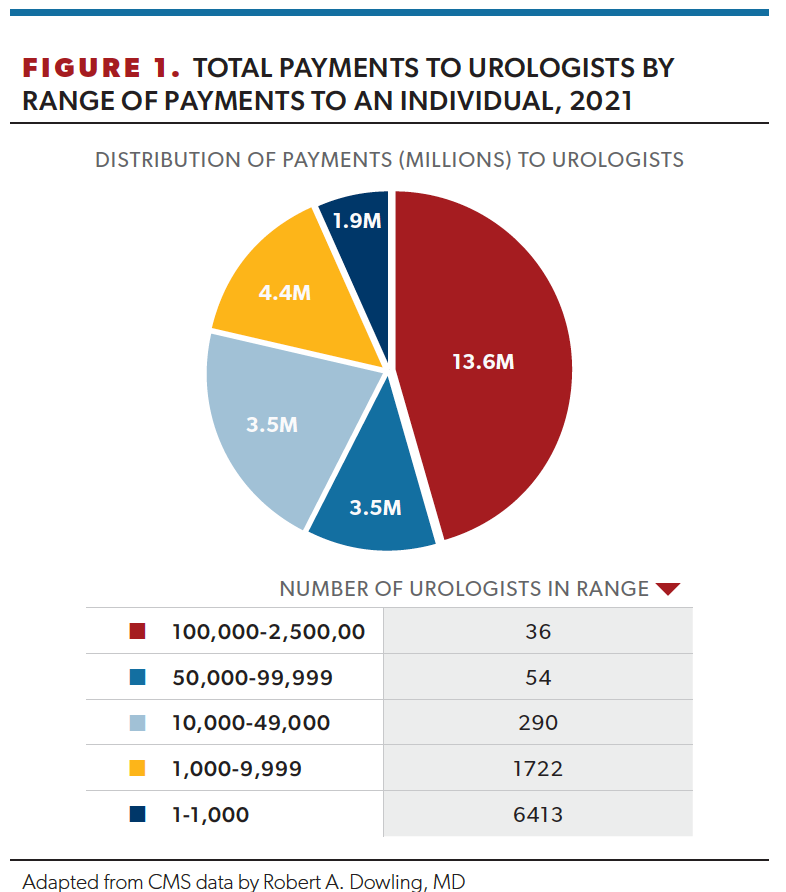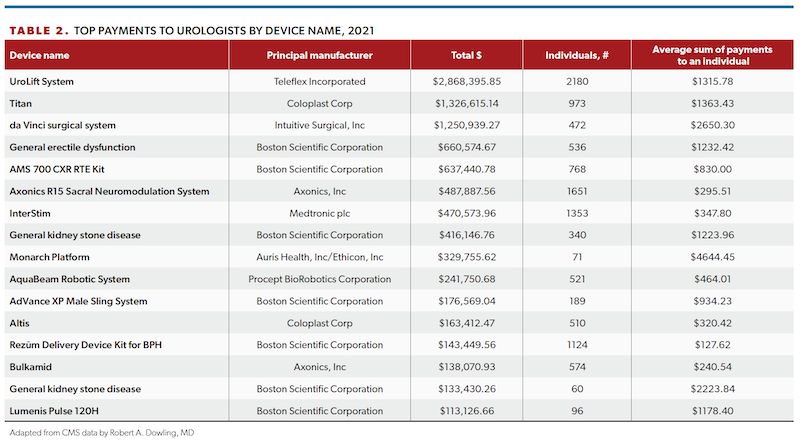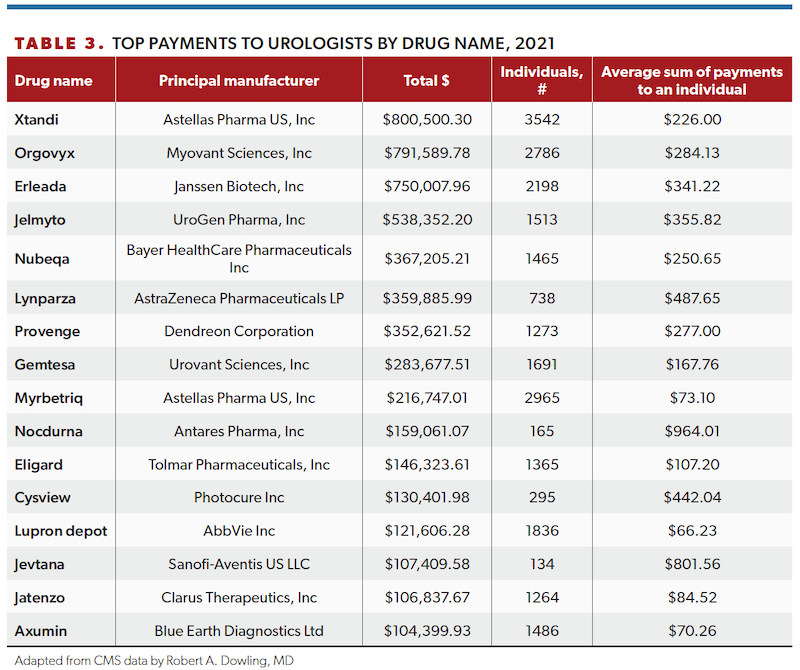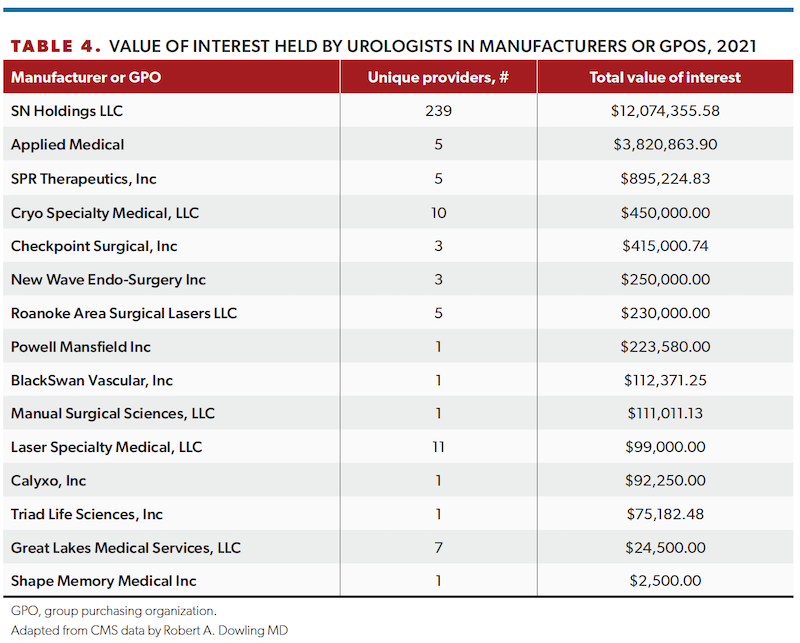Article
What’s in the 2021 Open Payments update?
Author(s):
Most urologists received less than $1000 last year, data reveal.
Robert A. Dowling, MD

The Physician Payments Sunshine Act (Section 6002 of the Affordable Care Act) requires that manufacturers of “covered drugs, devices, biologicals, and medical supplies” and group purchasing organizations (GPOs) report payments and other transfers of value to physicians to the Centers for Medicare & Medicaid Services (CMS). These requirements stem from a concern that payments to individuals could influence or incentivize behavior and a belief that public reporting and transparency might deter inappropriate behaviors or relationships. Although the data published by CMS show that most of the dollars reported are concentrated in a small number of manufacturers and recipients,1-3 more than one study has shown an association between industry payments and physician behavior.4 A recent paper suggested that urologists who received industry payments from device manufacturers might be influenced to publish positive positions on that company’s device.5 On June 30, 2022, CMS released their annual update of Open Payments Financial Data (calendar year 2021).6 In this article, I review some information, trends, and analysis about the payments to urologists reported under this program.
How much money or value is transferred from manufacturers to physicians each year? In 2021, $10.9 billion in payments or investment value was reported by 1721 unique companies to physicians, nonphysician practitioners, and teaching hospitals and other entities. Most (70%) of the payments were for research studies. The total amount of general (non–research related) payments to 533,056 individual physician recipients was $2.04 billion, relatively unchanged from 2020. In all, 8515 urologists received a total of $29,654,875 (1.45%) of those general payments from 391 unique manufacturers; total general payments to urologists were up 30% from the previous year, but still lower than the previous 5 years. The largest single payment to a urologist was $2,407,379; the largest sum of payments to any urologist was $2,407,456.74; and the average sum of payments to a urologist in 2021 was $3482.66.
How many urologists receive substantial payments or transfers of value each year? In 2021, almost half the total payments went to only 36 (0.42%) urologists, who each received more than $100,000 (average, $376,445.89 in this subgroup). Most (75%) urology recipients received less than $1000 each (average, $292 in this subgroup). See Figure 1 for a distribution of payments by group.

What is the nature of manufacturer payments to urologists? Most of the payments are categorized as food and beverage, and manufacturers reached 8083 individual urologists with these payments, averaging almost $500 for each recipient. (Think drug representative lunches and industry dinners.) The largest payments, on average, went to small numbers of urologists for royalties (average, $256,669) and buyouts from an acquisition (average, $410,520). Last year, I called attention to the interest of the Office of Inspector General for the US Department of Health and Human Services in industry-sponsored speaking programs. It appears from the 2021 data that this category may account for up to 18% of manufacturer payments to urologists, with an average payment of $2400, an average number of 5 payments (range, 1-74), and an average recipient receiving a total of $13,109 (range, $100-$342,000) in 2021. For a complete list of payment types, see Table 1.

Although any individual urologist received, on average, less than $3500 in 2021, any individual manufacturer spent hundreds of thousands or millions of dollars in payments to urologists related to their product(s). Most of these payments ($17 million or 57%) were made by companies that associate the payment with a medical device; $7.1 million (24%) was associated with a drug or biological agent, and $5.5 million (18%) was not identified with a product at all. Excluding transfers of value related to royalties or acquisitions, the product associated with the largest total payments to urologists in 2021 was the UroLift system; Teleflex reported almost $3 million in payments to urologists, most as faculty or speakers for continuing medical education. For a list of the top payments by medical device name, see Table 2, and for top payments associated with a drug or biological agent see Table 3.


The Open Payments program also tracks the value of ownership or investment interest in manufacturing companies or GPOs. Are physicians, including urologists, getting rich from actual ownership positions in manufacturers and GPOs? Only a small number. In 2020, $1.12 billion of value was reported for all physicians, and $36 million (3%) of that was attributed to 445 urologists from 15 entities; in 2021, $1.26 billion of value was reported for all physicians, only $19 million (1.5%) of which was attributed to 396 urologists from 16 entities. One company accounted for 63% of the value of urology ownership reported and 60% of the urologists reporting ownership interest (see Table 4).

The bottom line and why it matters
Payments from industry—pharmaceutical manufacturers and device companies—to physicians continue to be examined by the federal government, policy makers, and watchdog agencies. Although most urologists received less than $1000 in 2021, a small number of recipients received very large transfers of value for royalties, acquisition payments, or industry speaking fees. It is not possible using this data set alone to draw any firm conclusions about whether industry payments influenced any individuals to choose a device or drug for their patients, nor whether publishing this information has curtailed inappropriate behavior. Urologists should understand that policy makers and academics continue to seek answers to these important questions, and authors who have joined Open Payments data to payer utilization data (such as Medicare billing) are reporting a possible association—especially with medical devices among surgical specialists.5,7

















